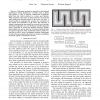533 search results - page 55 / 107 » Predicting location using mobile phone calls |
IPSN
2010
Springer
14 years 3 months ago
2010
Springer
A noise map facilitates monitoring of environmental noise pollution in urban areas. It can raise citizen awareness of noise pollution levels, and aid in the development of mitigat...
MHCI
2005
Springer
14 years 3 months ago
2005
Springer
We combine the functionality of a mobile Global Positioning System (GPS) with that of an MP3 player, implemented on a PocketPC, to produce a handheld system capable of guiding a u...
IROS
2009
IEEE
14 years 4 months ago
2009
IEEE
— This paper presents an approach to time-optimal kinodynamic motion planning for a mobile robot. A global path planner is used to generate collision-free straight-line paths fro...
ICC
2007
IEEE
14 years 4 months ago
2007
IEEE
— Many broadband wireless access (BWA) systems, such as IEEE 802.16e, support high-mobility users traveling at vehicular speeds. BWA systems capable of high data rates and low bi...
MOBISYS
2009
ACM
14 years 10 months ago
2009
ACM
PEIR, the Personal Environmental Impact Report, is a participatory sensing application that uses location data sampled from everyday mobile phones to calculate personalized estima...

